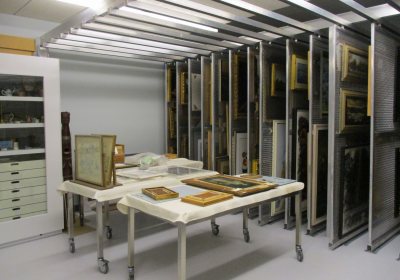Art Not Seen: The Purposes of Museum Storage

Storage at Bates College Museum of Art
This semester as a Collections Intern, I’ve spent a lot of time accessioning and cataloging donations or museum purchases and adding them to the database. In doing this, much of my time was also spent in the museum’s storage, moving and organizing works. A museum’s private storage is an area that most appreciators of art never get the chance to see, which begs the question: how much of the world’s art is in museum storage? Furthermore, what are the implications of having vast amounts of work that rarely meet the public eye?
Before I attempt to answer these questions, I’d like to note a few things about the Bates Museum of Art. The Bates Museum’s gallery space is relatively small, especially in comparison to that of museums such at The Met or The MoMA, which limits how much art can be shown at any given time, even though the exhibitions rotate year round. However, The Bates Museum benefits from its smaller size in that the Museum is able to work with students and professors to organize viewings of works not on display. The museum is also working towards the digitization of the entire permanent collection so that images and information on each piece can be viewed online by the public.
Many larger museums don’t have the capacity to offer such services due to the size of their collections and audiences. As a result, museums like The Louvre and the Guggenheim have less than ten percent of their collection on display at any given time. As a result, a large amount of artwork hides in storage until it gets its chance to shine.
However, to use the word “hiding” when discussing the storage of art by museums is a quite harsh. I believe that holding the art that is stored by museums and the art that is stored by private collectors to the same sort of standard is unfair. I don’t mean to criticize those who appreciate art and have the means to collect masterpieces. Many experience joy from owning and looking at these pieces, and in fact open private museums and galleries for public viewing of their collections. But it is also important to note that art is considered an investment, and can be purchased as such with little regard for its cultural significance. As a result, sometimes when a collector purchases a piece of art, either for personal enjoyment or investment reasons, it is never seen by the public again.
So, if museums have all this art, and their purpose is to show it, then why not? The first problem with this is that there simply isn’t enough space, even if every piece was hung edge to edge. Additionally, this method of hanging would cause a visual overload, preventing viewers from really seeing the art that they came to appreciate. Furthermore, museums have an even greater, historical responsibility. Plenty of art in a museum storage is simply too fragile to be displayed all the time and can only be exposed to light for small periods of time. Additionally many pieces in storage must undergo restoration processes before they can even be considered for exhibition. Museums also own and store plenty of work that was perhaps never meant for exhibition, but was acquired in order to preserve, for educational purposes for those who would study or write about it in the future.
Moreover, for every piece a museum wants to put up, another must come down. What is put on display at museums is carefully chosen and researched, and museums have an obligation to show what is culturally significant at the moment. Art museums serve as lasting collections of what matters to the public, and do so by recording the history of the world’s social landscape through the exhibitions they choose to show. The museum’s role is more than just conserving or displaying but influencing how we grow by shaping what we see and how we see it.
For further reading about other museum storage, visit:
http://www.bbc.com/culture/story/20150123-7-masterpieces-you-cant-see
https://qz.com/583354/why-is-so-much-of-the-worlds-great-art-in-storage/
Erica Moore, ’19
Economics and Studio Art Major